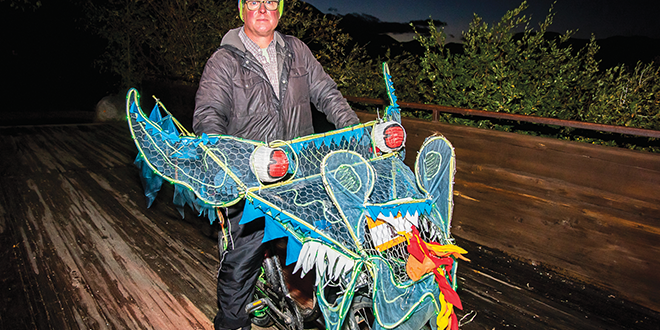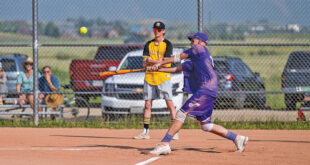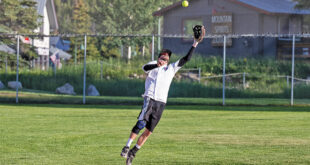Pat O’Neill runs 100 miles, Michael Blunck rides 262 miles
by Than Acuff
The Gunnison Valley is known for its long list of local athletes. It’s also known for an overwhelming amount of philanthropy. Recently, two local men committed themselves to their own personal physical and mental endeavors for two local non-profits.
Pat O’Neill ran 100 miles in the Idaho Mountain Trail Ultra Festival from Saturday, September 12 to Sunday, September 13, raising $63,000 for Living Journeys. Meanwhile, Michael Blunck jumped on his townie, as he has in the past, to ride 262 miles, 99 laps total, in the COVID-era Bridges of the Butte for two weeks to raise $8,835 for the Adaptive Sports Center.
Running down cancer
O’Neill has three Elk Mountains Grand Traverse race titles to his name and jumped into the ultra running fray with his first 100-mile race in 2010. He has run in a 100-mile race every summer since then.
In the meantime, as he continued his Grand Traverse race effort, he turned it into a fundraiser using the Grand Traverse as a way to raise money for cystic fibrosis, Six Points and the Adaptive Sports Center on three different occasions.
This summer, he decided to train and run in the Idaho Mountain Trail Ultra Festival (I.M.T.U.F.) to raise awareness and money for Living Journeys.
Upon retiring from 27 years of teaching, O’Neill joined the Living Journeys board. When COVID hit last spring, it was obvious that it would have an impact on Living Journeys’ summer fundraiser Peak Hike and Half Marathon and an idea was born.
“Because of the pandemic, we knew the Peak Hike and Half-Marathon would be virtual so we didn’t know what that would mean for Living Journeys,” explains O’Neill. “I made the focus of the I.M.T.U.F race to raise money and awareness for Living Journeys.”
Starting on June 1, O’Neill started getting the message out about his goal of running in the race and set his initial fundraising goal of $44,000. By the time he finished training and racing, he had raised $63,000 for Living Journeys.
“I picked $44,000 as the initial goal because 44 was the number worn by Jim Brown, Floyd Little and Ernie Davis and thought it was a totally lofty goal,” says O’Neill. “I reached $63,000, which is totally mind-boggling.”
While 100-mile races in the past have often been about personal challenge, this one stretched far beyond that and was far bigger than just one person. As a result, O’Neill’s typical race plan was more than just about time, place and decisions made out on course with that in mind. It was about people with cancer, cancer survivors, people who have died from cancer and their friends and families.
“My approach to the race was completely different,” says O’Neill. “Eating and drinking, cooling down and warming up at aid stations was the primary focus to get the job done for Living Journeys clients and family members. I have 300 donors and dozens of Living Journeys clients. This race is not about me. I cannot not finish.”
Yet, even with a “conservative” approach, O’Neill still had 106 miles of running to do with over 20,000 feet of climbing thrown in there.
“It seemed like wherever the course could go back up, it would,” says O’Neill.
Things started to unravel a little when he rolled into the aid station at mile 48, having covered the past two to three miles in the dark with no headlamp and no water. A longer than usual break got him refreshed but as he headed out onto the next section, he found a first-time 100-mile runner alone and struggling. He spent the next five to six miles trying to get her through it but at mile 65 he found out he had one hour and 15 minutes to make it to mile 70 before the time cutoff.
“I had lost mad time,” says O’Neill.
It was also at that moment, at 3 a.m. out on the trail, that he received a message.
“I actually heard the voice of someone I know battling cancer say ‘Your strength is limitless,’” says O’Neill.
He ran the next five miles in 45 minutes, reached the aid station at mile 70 with time to spare and then went into overdrive with his pacer for the final 36 miles.
“After mile 70 we went bonkers,” says O’Neill.
He ended up crossing the finish line after 33 hours of running, coming in 54th place, second in his age group, but that all meant little to him in the bigger picture.
“No one should fight cancer alone and the whole thing became bigger than me,” says O’Neill. “I had this thought out there. Winning is not wanting to win. Winning is making sure other people win.”
He also had a special inspiration for the race among the Living Journeys extended family.
“I did it to honor the memory of Pat Anderson,” says O’Neill.
Riding round and round
Michael Blunck stepped into his philanthropic role with the Adaptive Sports Center, first riding in the 24 Hours Bridges of the Butte eight years ago. But it was his involvement well before that when he was first hooked on helping out the organization.
“I volunteered for Adaptive and when this guy showed up he was a paraplegic from the first Iraq war,” recalls Blunck. “When I first saw him when he showed up I was afraid he was ready to take his own life. Five days later skiing with Adaptive I saw the Adaptive Sports Center had changed his life. That was a turning point for me.”
He gains additional inspiration every year in a little more personal manner from a friend who has a son with cerebral palsy.
“Every day they have challenges they have to face in life,” says Blunck. “In the ‘normal’ 24 Hours Bridges I challenge myself to try to somewhat understand what they deal with on a day to day basis. It makes me appreciate all that I have.”
This year COVID changed up the Bridges of the Butte event significantly from numerous participants riding 24 hours straight through, to an individual event over an extended period of time. Remarkably, Blunck managed to raise more money than ever before, earning the High Roller belt buckle for the sixth time.
“My original goal was $6,000 but I got there pretty quick so I upped it to $8,000 and almost raised $9,000,” says Blunck. “It didn’t do $60,000 like Pat but I didn’t do it as long either.”
Starting on Saturday, August 29, Blunck rode two hours a day for 13 out of 15 days straight on a “reverse” Bridges loop because of the one-way designation on Elk Avenue.
“I didn’t want to ride the wrong way on Elk Avenue and upset the cops,” explains Blunck. “They did yell at me some for blowing through stop signs.”
The two days he missed were for family on one day and then the September snow day.
“I was going to ride but I had no idea the snow was going to stick to the roads,” says Blunck. “I thought I’d end up wiping out and wreck myself. The street slicks aren’t very good in snow.”
What the 24 Hours Bridges of the Butte will look like in the future is anyone’s guess and Blunck admits he’s not a fan of the 12-hour idea. But, that’s still not going to stop him.
“I don’t see myself stopping,” says Blunck. “Doing the night part is the fun part for me but I’m certainly not going to stop supporting the Adaptive Sports Center.”
O’Neill will continue his work for Living Journeys as well. As a board member, he has an idea to create a Living Journeys Athletic Corps. Three athletes, in different sports ideally, will apply to join the corps and be charged with doing two events each year, raising $10,000 per event. In addition, he will keep on doing what he does.
“My athletic endeavors will be dedicated to raising awareness and money for Living Journeys,” says O’Neill. “Living Journeys clients are my heroes.”
 The Crested Butte News Serving the Gunnison Valley since 1999
The Crested Butte News Serving the Gunnison Valley since 1999




